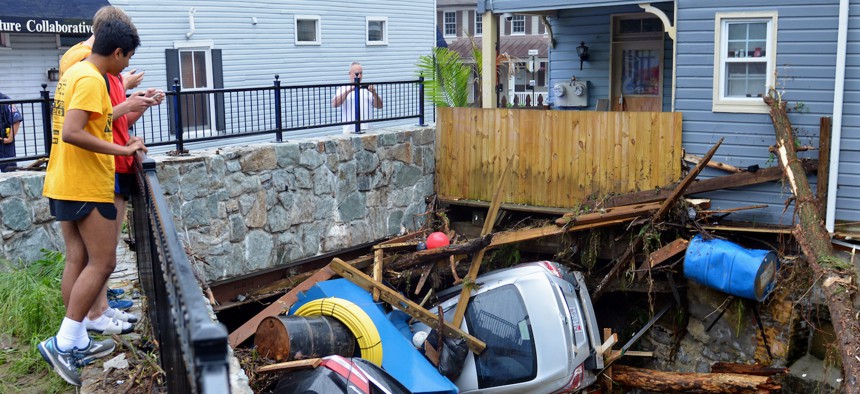Flood Clean-up Begins in a Historic Maryland Mill Town. Again.

Residents gather by a bridge to look at cars left crumpled in one of the tributaries of the Patapsco River that burst its banks as it channeled through historic Main Street in Ellicott City, Md. David McFadden / AP Photo
Unlucky topography and an intense rainstorm creates a major disaster in Ellicott City for the second times in nearly two years.
Sunday’s destructive flash flooding in Ellicott City, Maryland, a community where parts of the historic central business district are built atop a point where several small tributaries converge before entering the Patapsco River west of Baltimore, is the second such event in less than two years to bring an inundation with such force that carried cars down Main Street, rip through businesses and homes.
Gov. Larry Hogan declared a state of emergency due to the flooding in Ellicott City and elsewhere in the state as Main Street in the historic mill town remained closed for damage assessment.
A member of the Army National Guard was reported missing in Sunday’s flash flooding after a rainstorm dumped incredible amounts of precipitation—The Washington Post reported that some automated rain gauges in nearby Catonsville saw 13 to 15 inches of rain—on the area. That intense rainfall combined with the city’s unlucky topography created a repeat disaster, which came just as many businesses and residents were starting to recover from the July 2016 floods.
The Ellicott City disaster is prompting questions about whether businesses should rebuild and about what can be done to reduce the risk of flash flooding.
Last year, Howard County officials released plans for a series of infrastructure projects to help better control water through the historic city during high-precipitation events, including three dry retention ponds designed to hold water upstream instead of draining down through town in a short amount of time.
"These projects will allow us to retain more water in the upper reaches of the watershed and they will improve the way we move water downhill," Howard County Executive Allan Kittleman said, according to The Baltimore Sun. "Basically, making water less likely to back up and flood the streets and our homes."
The new flooding in Ellicott City highlights the necessity for those projects, which were estimated to cost $18 million.
Earlier this month, flash floods swept through Frederick, another historic Maryland city.
PREVIOUSLY on Route Fifty:
Michael Grass is Executive Editor of Government Executive’s Route Fifty and is based in Seattle.
NEXT STORY: When Rivers Come to 'Greet' a City






